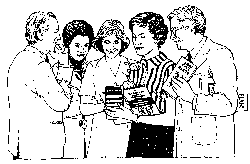
Webster's dictionary defines communication as an act of transmitting information; a process by which information is exchanged between individuals; a technique for expressing ideas effectively.
It sounds so easy, doesn't it? What's so hard about good communication? The answer to that question lies not in understanding the concept of communication, but in practicing effective communication in community association management. It is the key that will open the door to good client relationships.
Communicating Expectations:
The development of good relationships between management companies and homeowners associations begins before the management contract is ever signed. During this process, it is the responsibility of the members of the association's board of directors to clearly communicate their expectations of management to the company which they have retained. The management services agreement is the tool used to develop and formalize these expectations. Typically, copies of the management contract are distributed to the board of directors for their review and with the assumption being made that these homeowners will read the entire contract - - and will understand and agree to the provisions of the contract. At this point, many future problems can be avoided by taking the few minutes that would be required for the management company to request a meeting of the board members to review each provision of the contract. This can be invaluable in establishing clear expectations between the association, its board members, and the management company's representative. If at all possible, the process should include the actual manager that will be assigned to the community.
Maintaining Effective Communication:
Developing and maintaining a good level of communication between the association board of directors and the management company is a key element in the ability of the management company to retain clients over the long term. This is also important for any association in order to avoid the need for frequent changes in management.
To avoid miscommunication resulting in erroneous actions being taken by management, the board of directors needs to be very succinct in the direction given to management. Conversely, it should be the responsibility of management to clarify any ambiguity that might exist in actions taken by the board. In many cases, without that clarification, even members of the board of directors may leave meetings with different understandings on the actions taken by the board and the tasks expected to be handled by management. One technique that can be used to avoid any such misunderstanding is to clarify and summarize at the close of each meeting all actions taken by the board. This could include reading back any motions approved by the board, preparing an action items list, and reviewing a report of open items scheduled for action or completion.

Promptly following the meeting, the minutes of the meeting should be completed with copies forwarded to the board members for their review and approval. This is yet another way of affirming with the board the actions taken at their meeting. Relative to an action items list completed by the manager, this time honored technique not only confirms the actions expected by the board but also provides both the board and manager a business plan of sorts. Weekly updates of this plan supplied to the board members, assures good communication and greater efficiency for the group as a whole. This also gives the board the information needed to be more effective in communicating to the entire membership of the association. Board members need to know the status of items requested to be completed by the management company. Often, without that communication, board members make the assumption that items are not being addressed. Timely communication with board members results in a higher level of confidence with the management company.
Communicating with the Homeowners:
It is the responsibility of the association board of directors to communicate the status of association activities and board actions to the membership (homeowners) within the association. Without this communication, members in the community often tend to believe that the board may be doing things that they shouldn't be doing or doing nothing at all! It's always better to provide too much rather than too little information to those inquiring minds living within a community association.
Several tools can be used to effectively communicate information to the homeowners. The monthly meetings of the association can provide a forum for the board members to report on association activities. In addition, newsletters and other forms of written communication, whether mailed, hand delivered, or posted on a community bulletin board, can be effectively used to distribute information to the homeowners.
Association websites can also be developed and maintained at minimal cost to homeowner associations. These websites can be invaluable in the dissemination of information to the members of the association and can contain financial information, on-line newsletters, rules and regulations, architectural guidelines, and governing documents as well as other information that the board would like to pass on to the membership.
In some instances, associations located within the boundaries of certain cable franchises have been able to negotiate their own local cable channel for making announcements of upcoming events. Although this can be labor intensive, it is a very effective means of providing current information to the members of a large scale association.
In summary, good communication can be the deterrent to a variety of ills that an association may otherwise encounter. To be effective, communication must be timely and succinct. A variety of tools exist for the establishment of communication within an association. Both management and the association board share responsibility for establishing and maintaining communication between themselves and the membership at large. Once they do so, they will likely have mastered the art of building a long and satisfying relationship among a very diverse community of interests.
 Print
Print Email
Email







